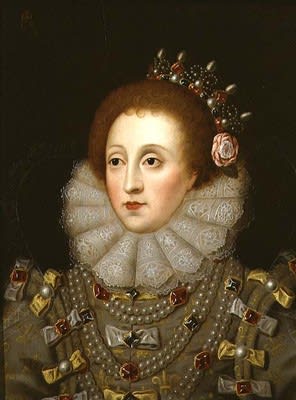
Anglo-French School
Portrait of Queen Elizabeth I (1533-1603), c. 1600
Oil on panel
22 3/4 x 17 1/2 in. (57.8 x 44.5 cm)
Philip Mould & Co.
To view all current artworks for sale visit philipmould.com This portrait of Queen Elizabeth may well have hung in the long-gallery or corridor of a great house in England...
To view all current artworks for sale visit philipmould.com
This portrait of Queen Elizabeth may well have hung in the long-gallery or corridor of a great house in England or in France, where in a succession of other portraits of English and European princes, as well as prominent courtiers and great men of the past and present it would have established the owner as a loyal subject, as well as a man firmly anchored in the renaissance chain of being. In date and composition this portrait recalls not only examples in the great houses of England and Scotland, but in other countries, most notably the collection of corridor portraits at Chateau Beauregard in the Loire valley, in which some three hundred portraits depict not only worthies of ancient and modern history, but the royalty of England and France and their chief ministers.
In execution the portrait appears to date to the late seventeenth century, and although the magnificence of the costume resembles those worn by the Queen in Marcus Gheeraerts’s Ditchley Portrait (National Portrait Gallery) or The Rainbow Portrait (Hatfield House), the details are a later and more generalised recollection of Elizabethan dress, and the fashion of the ruff confirms a date in the early seventeenth century.
The Queen’s face resembles earlier likenesses, especially those of the 1570s such as The Ditchley Portrait (National Portrait Gallery), which it recalls in reverse. As Sir Roy Strong observes, this latter portraits ‘in various forms, reversed and reattired ad infinitum was to be used until her death.’1 The present portrait demonstrates that the likeness acquired great currency as the definitive icon of the Queen, to the extent that it is here used in a posthumous representation, at once recognisable as the Queen to later and foreign audiences.
This portrait of Queen Elizabeth may well have hung in the long-gallery or corridor of a great house in England or in France, where in a succession of other portraits of English and European princes, as well as prominent courtiers and great men of the past and present it would have established the owner as a loyal subject, as well as a man firmly anchored in the renaissance chain of being. In date and composition this portrait recalls not only examples in the great houses of England and Scotland, but in other countries, most notably the collection of corridor portraits at Chateau Beauregard in the Loire valley, in which some three hundred portraits depict not only worthies of ancient and modern history, but the royalty of England and France and their chief ministers.
In execution the portrait appears to date to the late seventeenth century, and although the magnificence of the costume resembles those worn by the Queen in Marcus Gheeraerts’s Ditchley Portrait (National Portrait Gallery) or The Rainbow Portrait (Hatfield House), the details are a later and more generalised recollection of Elizabethan dress, and the fashion of the ruff confirms a date in the early seventeenth century.
The Queen’s face resembles earlier likenesses, especially those of the 1570s such as The Ditchley Portrait (National Portrait Gallery), which it recalls in reverse. As Sir Roy Strong observes, this latter portraits ‘in various forms, reversed and reattired ad infinitum was to be used until her death.’1 The present portrait demonstrates that the likeness acquired great currency as the definitive icon of the Queen, to the extent that it is here used in a posthumous representation, at once recognisable as the Queen to later and foreign audiences.
Literature
Sir Roy Strong Tudor and Jacobean Portraits, Vol. 1, HMSO, 1969, p. 110Be the first to hear about our available artworks
* denotes required fields
We will process the personal data you have supplied in accordance with our privacy policy (available on request). You can unsubscribe or change your preferences at any time by clicking the link in our emails.